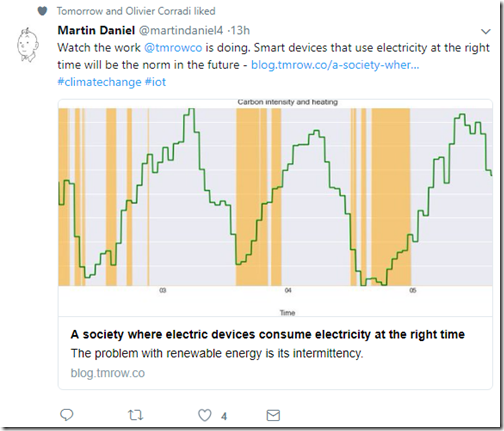This week many energy eyes were focused on some goings-on in Australia (not the least of which because of the commencement of operations at the “worlds biggest battery”, which surely must be a short-lived title).
Further afield, I did notice this article from the founder of the innovative, internationally-focused Tomorrow visualisation product (a more usable representation of data than our earlier LiveGen project). Oliver Corradi’s article was the first one I’d seen from him – and turns out to be only the 5th on the site, so I did not miss as many as I initially thought. Oliver’s post initially came to my attention through snippets like this on social media:
I can totally understand the motivation for helping energy users consume energy at “the right time” – after all, we have been helping large energy users in Australia’s east coast grid (the confusingly named “National Electricity Market” make this decision in reverse for more than a decade – i.e. identify when not to consume, to avoid consumption at times of very high spot prices as a large form of Demand Response in the NEM as noted here today as well – LINK TO COME).
I also understand that other consumers, making a different value judgement, will be focused on ensuring the emissions intensity of the electricity they consume will be as low as it will possibly be – which has primarily been through procurement processes such as building their own wind and solar power stations (some results from mine here). The idea of timing consumption in the spot market
However I would just like to add a note of caution – as this is something that others had approaches us about over the years, with their desires based on some mistaken beliefs.
With the thought being that Oliver might have also fallen into the trap of the same mistaken beliefs, I read the article fully (and also the others as well – and was happy to see how he wrote back in May about one of the other mistaken beliefs in “No country X did NOT run entirely on wind” (a trap I’ve seen people fall into all to frequently in this energy transition) I particularly appreciate his admonition that “Instead of focussing on how much renewable we produced, let’s focus on how much CO2 we emit…” – as it’s long been noted that people “manage what they measure” (so do societies) so it is another timely reminder with the toxic debate in Australia about focusing on the right target in the first place.
Back to his more recent article, however, I was a bit disappointed to read this particular bit:
“Wouldn’t it make sense to build a society where our electric devices consume electricity at the right time? We strongly believe so. As a proof of concept, we collaborated as part of the CITIES project in building a device that would react to changes in carbon intensity.”
Whilst we can understand the emotional connection with shifting consumption to when average emissions intensity is low, it is the marginal generation that should be used to drive these decisions – if emissions reduction is the prime driver for a particular consumer. Falling into an all-too-common trap of focusing on averages appears to be what Oliver and his team have done in the “CITIES Project” he references.
I don’t have time to go into the details much further here, but consumers who really are driven to reduce their emissions footprint should avoid “vanity metrics” (like average intensity) and instead focus on more practical (though much harder to ascertain!) metrics like the emissions intensity of the next MWh (or kWh) that might be produced if they were to increase their consumption by that next MWh (or kWh).
In practical terms, because solar and wind production is intermittent and near-zero marginal cost, it is almost always on the bottom of the bid stack, so is dispatched first. Hence it will typically be some other type of dispatchable plant that is the one that is being called on to ramp up, or down, to meet change in residual demand – except, perhaps, in rarer cases if the solar or wind production were being curtailed for some form of system/network reasons such as analysed here for South Australia earlier this year.
I don’t mean to rain on Oliver’s party, as the company seems to be doing some quite interesting, innovative and worthwhile things. Just want to ensure we’re all doing our bit to raise the level of Energy Literacy (category and tag) to address the growing challenges in this energy transition.
—————–
PS in June 2022
Worth attaching to this article the article ‘Marginal vs average: which one to use in practice?’ Olivier Corradi has written in June 2022 about this topic



Hi Paul,
Olivier here. Thanks for relaying our messages.
We definitely agree that the marginal should be used.
It’s actually already available at pro.electricitymap.org.
Will write another article about that pretty soon.
Olivier